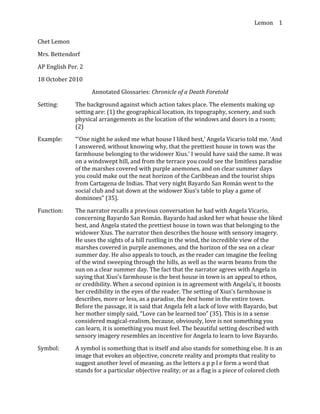Annotated glossaries chronicle of a death foretold
- 1. Chet Lemon<br />Mrs. Bettendorf<br />AP English Per. 2<br />18 October 2010<br />Annotated Glossaries: Chronicle of a Death Foretold<br />Setting: The background against which action takes place. The elements making up setting are: (1) the geographical location, its topography, scenery, and such physical arrangements as the location of the windows and doors in a room; (2) <br />Example:ŌĆ£ŌĆÖOne night he asked me what house I liked best,ŌĆÖ Angela Vicario told me. ŌĆśAnd I answered, without knowing why, that the prettiest house in town was the farmhouse belonging to the widower Xius.ŌĆÖ I would have said the same. It was on a windswept hill, and from the terrace you could see the limitless paradise of the marshes covered with purple anemones, and on clear summer days you could make out the neat horizon of the Caribbean and the tourist ships from Cartagena de Indias. That very night Bayardo San Rom├Īn went to the social club and sat down at the widower XiusŌĆÖs table to play a game of dominoesŌĆØ (35).<br />Function:The narrator recalls a previous conversation he had with Angela Vicario, concerning Bayardo San Rom├Īn. Bayardo had asked her what house she liked best, and Angela stated the prettiest house in town was that belonging to the widower Xius. The narrator then describes the house with sensory imagery. He uses the sights of a hill rustling in the wind, the incredible view of the marshes covered in purple anemones, and the horizon of the sea on a clear summer day. He also appeals to touch, as the reader can imagine the feeling of the wind sweeping through the hills, as well as the warm beams from the sun on a clear summer day. The fact that the narrator agrees with Angela in saying that XiusŌĆÖs farmhouse is the best house in town is an appeal to ethos, or credibility. When a second opinion is in agreement with AngelaŌĆÖs, it boosts her credibility in the eyes of the reader. The setting of XiusŌĆÖs farmhouse is describes, more or less, as a paradise, the best home in the entire town. Before the passage, it is said that Angela felt a lack of love with Bayardo, but her mother simply said, ŌĆ£Love can be learned tooŌĆØ (35). This is in a sense considered magical-realism, because, obviously, love is not something you can learn, it is something you must feel. The beautiful setting described with sensory imagery resembles an incentive for Angela to learn to love Bayardo. <br />Symbol:A symbol is something that is itself and also stands for something else. It is an image┬Āthat evokes an objective, concrete reality and prompts that reality to suggest another level of meaning. as the letters a p p l e form a word that stands for a particular objective reality; or as a flag is a piece of colored cloth that stands for a country. All language is symbolic in this sense, and many of the objects that we use in daily life are also.┬ĀIn a literary sense a symbol combines a literal and sensuous quality with an abstract or suggestive aspect. It is advisable to distinguish symbol from IMAGE, ALLEGORY, and METAPHOR. If we consider an image to have a concrete referent in the objective world and to function as image when it powerfully evokes that referent, then a symbol is like an image an image in doing the same thing but different from it in going beyond the evoking of the objective referent by making that referent suggest a meaning beyond itself; in other words, a symbol is an image that evokes and objective, concrete reality and prompts that reality to suggest another level of meaning. The symbol evokes an object that suggests the meaning. As Coleridge said, ŌĆ£It partakes of the reality which it renders intelligible.ŌĆØ In allegory the objective referent evoked is without value until it is translated into the fixed meaning that it has in its own particular structure of ideas, whereas a symbol includes permanent objective value, independent of the meanings that it may suggest. In ŌĆ£The Rhetoric of Temporality,ŌĆØ Paul de Man argues that ŌĆ£Whereas the symbol postulates the possibility of an identity or identification, allegory designates primarily a distance in relation to its own origin, and, renouncing the nostalgia and the desire to coincide, it establishes its language in the void of this temporal difference.ŌĆØ A metaphor evokes an object in order to illustrate an idea or demonstrate a quality, whereas a symbol embodies the idea or the quality. As W. M. Urban said, ŌĆ£The metaphor becomes a symbol when by mean so fit we embody an ideal content not otherwise expressible.ŌĆØ<br />Example:ŌĆ£SheŌĆÖd finished sweeping the courtyard, and when my sister Margot went out to meet the bishop she found her grinding manioc for the fritters. ŌĆśCocks could be heard,ŌĆÖ my mother is accustomed to saying, remembering that day. She never associated the distant uproar with the arrival of the bishop, however, but with the last leftovers from the weddingŌĆØ (21).<br />Function:Gabriel Garc├Ła M├Īrquez uses biblical parallelisms directly in the names of his characters to further develop a biblical symbol. The killerŌĆÖs names in the book are Pablo and Pedro, which are quite similar to, and are symbolic of Paul and Peter, the men who crucified Jesus Christ in the Bible. Peter did not actually kill Jesus, however he denied him the chance of innocence numerous times before the cocks crowed. This is almost exactly a reflection of PabloŌĆÖs actions in the novel. Even though Pablo did not directly murder Santiago, he refused to accept any pleas for innocence before the crowing of the cocks. Pretty much every name in the book has a parallel character in the Bible. M├ĪrquezŌĆÖs use of biblical parallelisms in the names of his characters helps the reader to understand the symbol of the crowing cocks.<br />


